
Firstly, make sure that no matter what, you get to the bottom of this post to play the video Matt has kindly let me share with you.
Last week, you met Matt Redman, a pen pal of mine from the U.K. who I met just this last February. For his authentic musical recreations of early 1900s BMG (banjo, mandolin & guitar) music, Matt has been keen to acquire examples of an early American mandocello and harp guitar.
To that end, he first stopped off at mutual friend Matt Wood’s place to compare mandocellos (I’ve only the one, Matt is obsessed with them). He then stopped here for the full harp guitar experience, where I tried to talk him into taking home something I actually had for sale! But no, it turned out that Matt is Gibson-crazy. After getting a vintage Gibson L-4 oval-hole archtop a couple years ago (below), he seems to have found his sound.


And so, after unsuccessfully trying to convince him a flat-top was the way to go (he was after volume, and the Carlson at left is as loud as it gets!), we brought out the Gibsons. Matt is now on a quest to get one of the later, common Gibson Style U’s. Yes. what I (and the majority of modern American harp guitarists) find jarring and toneless, Matt considers heaven. He just loves that sound.
He may be one of the few playing Gibsons authentically, stringing his L-4 with heavy strings and just wailing on it. His shows are generally all acoustic, and with proper Gibson tension and technique, I suspect he can fill most any hall. As you listen to him play in my room, realize that if we strung these instruments with period strings (so heavy though don’t even make them anymore) they’d sound even louder and punchier.
You’ve heard me play some of these on recordings, but I typically use my antique instruments only for modern music and arrangements. These 13 minutes of clips will give you an idea of what these instruments can sound like in a specialist’s hands, and also what sort of music might have been played on them by early 1900s soloists. For harp guitar music historians specifically, this is important as all of these tunes might have been played by harp guitar accompanists, if not by the better soloists. Mind you, this is just a tiny sample of what Mr. Redman is capable of.
Unfortunately, I keep my valuable instruments strung with light strings and tuned down a couple steps when not in use. We tuned most up to full pitch, but most were still too lightly strung for Matt’s forceful technique. Me? I can barely fret those Gibsons up the neck, but Matt had no problem playing with his trademark passion and dynamics.
Before watching the video (at page bottom), here are further details, caveats and notes on the instruments and Matt’s tunes:
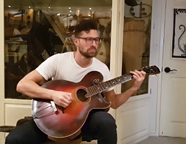
Gibson Style O Artist: A funky-sounding old archtop guitar, virtually identical in construction and sound to Matt’s L-4. He liked mine a little better, even though its strings are 25-years old (just as I had left them after recording its Christmas Collection piece). He claimed he could hear the difference between the quality of the (birch) wood selection…!
In the clip, Matt first explains that he couldn’t find a 1910-era waltz challenging enough for a solo showpiece in the “plectrum style,” so wrote his own “period” piece, “La Carnauba Waltz.” The title is not just a clever gag – Matt actually released this as a wax cylinder that you can buy and hear “authentically”! OK, that’s just too cool. It’s what you hear under the opening credits.
He next jams on “‘Tain’t no Sin (To Dance Around in Your Bones),” a popular early 1930s dance band tune (later covered by Tom Waits, which seems perfect). Then a quick snippet of Kern/Mercer’s “I’m Old Fashioned” made popular by Fred Astaire & Rita Hayworth in You Were Never Lovelier.
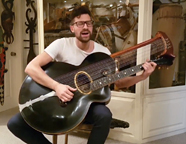
Gibson 18-string HG (the super-rare, long-scale 12-sub-bass one): While the neck is strung in light silk & steel, the subs are purely decorative – a set of colored nylon-core Schrammel strings installed for our Carlsbad museum exhibit a couple years back. So there was nowhere near enough tension for his technique (and one bass tuner didn’t hold, so he skipped that one). He apologized for not singing on key, as he was so busy concentrating on the instrument! While the string colors match Gibson’s historical method (copper-color every other third string), Matt uses something completely different (a small knot of red cotton as a marker around his C and G bass strings) – but the new system barely bothered him. About the tune, he quickly says “This is 1919” but then later told me 1920, “made popular by Nora Bayes, then later the Andrews Sisters and Vera Lynn.”

Winsor 7-string bass zither banjo: Matt plays all the banjos, but this was probably his first 7-string. And he had to hear the bass version. This type of banjo has metal for the melody strings but gut and overspun silk for the rest (you heard me play it on Brad Hoyt’s Far Away From Everyday CD). This is an old American Civil War tune sung by the Union Army.
 Gibson ‘teens Style U: One of my least favorite-sounding harp guitars (and almost no modern American harp guitarist plays this model), yet Matt chose this model as the one he must get. Note how it almost sounds like an electric guitar in his hands. Again, projection for the back of the music hall. We both agreed that the unique 10-bass “re-entrant” Boehm tuning system is ideal, especially for the music he is playing. He’d never played one of these, and you’ll hear me ask how he can immediately get around on it … (damn virtuoso jazz music major…)
Gibson ‘teens Style U: One of my least favorite-sounding harp guitars (and almost no modern American harp guitarist plays this model), yet Matt chose this model as the one he must get. Note how it almost sounds like an electric guitar in his hands. Again, projection for the back of the music hall. We both agreed that the unique 10-bass “re-entrant” Boehm tuning system is ideal, especially for the music he is playing. He’d never played one of these, and you’ll hear me ask how he can immediately get around on it … (damn virtuoso jazz music major…)
He first noodles for a while (explaining later, “there’s a paraphrased fragment from Eddie Peabody in ‘Strum Fun,’ the rest is just scales and arpeggios, then a typical 3-chord waltz German folk tune accompaniment a la contra/Schrammel guitar style.”), then finally goes right into “Till We Meet Again.” Of this tune, he says, “From the end of the great war, into the 1919 flu epidemic, and 1920s. Introduced by Campbell and Burr, then later Doris Day, Patti Page and Bing Crosby. I have a video of me visiting the grave of (composer) Richard Whiting in Forest Lawn, Glendale, CA from December 2018 where this melody is written on his tombstone. I say the words to another of his songs. It was also the closing theme for Don Messer’s Jubilee on Canadian TV 1957-1969.”
 McGinnis & Shaw “Clef Club” banjolin: This 2016 museum addition is a prize. I would love to know who the “Ramblers” were! McGinnis & Shaw were professional but extremely obscure African American makers of plucked string instruments in Philadelphia. Though there may or may not have been a relationship, their “Clef Club” brand obviously refers to the famous Jim Europe-led orchestra and ensembles I’ve written about at length. You’ll remember how their main instrument was this little 4-string “melody banjo” (pre-tenor banjo). I had yet to play it and wanted to hear it, so handed it to Matt … a quick tune up, search his mental song Rolodex, and … blam! His later notes explained that this 1917 tune was recorded (with banjolin) by the Savoy Quartet in England. Harpguitars.net readers may remember that one of Vardon & Perry’s many “Wilbers” (Joe Wilbur) went on to play with the Savoy Q. (he predominately played guitar banjo with the Quartet).
McGinnis & Shaw “Clef Club” banjolin: This 2016 museum addition is a prize. I would love to know who the “Ramblers” were! McGinnis & Shaw were professional but extremely obscure African American makers of plucked string instruments in Philadelphia. Though there may or may not have been a relationship, their “Clef Club” brand obviously refers to the famous Jim Europe-led orchestra and ensembles I’ve written about at length. You’ll remember how their main instrument was this little 4-string “melody banjo” (pre-tenor banjo). I had yet to play it and wanted to hear it, so handed it to Matt … a quick tune up, search his mental song Rolodex, and … blam! His later notes explained that this 1917 tune was recorded (with banjolin) by the Savoy Quartet in England. Harpguitars.net readers may remember that one of Vardon & Perry’s many “Wilbers” (Joe Wilbur) went on to play with the Savoy Q. (he predominately played guitar banjo with the Quartet).
 Maccaferri harp guitar: Another wonderful instrument that appears on Brad’s CD (playing Gypsy jazz of all things), I forget why I handed this to Matt, other than maybe to feel the unique square, flat neck (and perhaps he was curious about a pre-Selmer Maccaferri). Another instrument strung (with Nylgut) a little too lightly for my Vaudevillian friend, and we also left it tuned down a half step. It was when Matt was trying to wrap his head around its 4-sub tuning that I discovered he has perfect pitch. My simple G-B-C-D was to him all flats, and to his ear and brain, he was playing in Gb, plain and simple. He just had to remember to play everything one fret higher in G! That level of professional musicianship I want nothing to do with…!
Maccaferri harp guitar: Another wonderful instrument that appears on Brad’s CD (playing Gypsy jazz of all things), I forget why I handed this to Matt, other than maybe to feel the unique square, flat neck (and perhaps he was curious about a pre-Selmer Maccaferri). Another instrument strung (with Nylgut) a little too lightly for my Vaudevillian friend, and we also left it tuned down a half step. It was when Matt was trying to wrap his head around its 4-sub tuning that I discovered he has perfect pitch. My simple G-B-C-D was to him all flats, and to his ear and brain, he was playing in Gb, plain and simple. He just had to remember to play everything one fret higher in G! That level of professional musicianship I want nothing to do with…!
Again, he’s playing a harp guitar form and tuning (and key) he’d never experienced before. He does always give it his all though!
Last but not least, this was all completely impromptu, and until Matt arrived, I had no idea what I had gotten myself into! He set his cellphone down just to capture some of these videos for reference, and he, then I, cleaned things up a bit. I’d like to thank Matt for allowing me to share these “authentic performances on historically-correct instruments” with you. May there be much more to come.

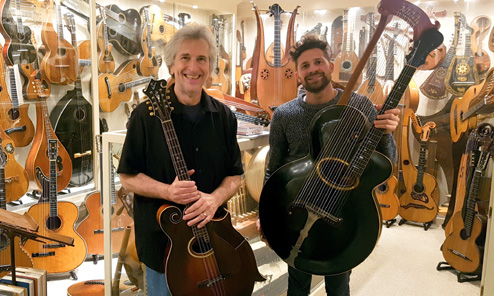

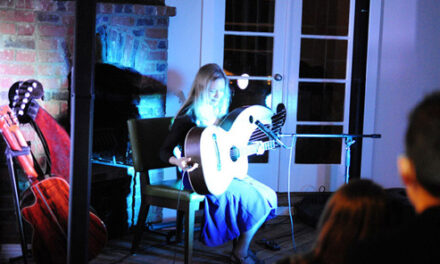


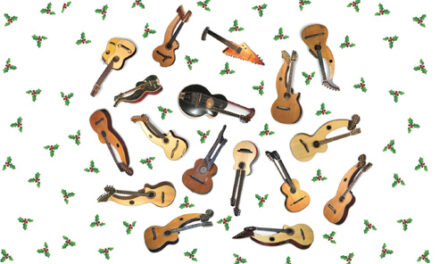
The video compilation was a joy to watch. Had me whistling afterwards. What an era of great tunes back then. Hope to hear more. Thank you to Matt for letting us be a fly on the wall.
That was Great!
Wow! Matt is amazing. I cannot imagine picking up all those varied instruments and just playing them on the spot. It makes me feel very inadequate. Thanks for sharing. I am sure you got a real charge out of this.